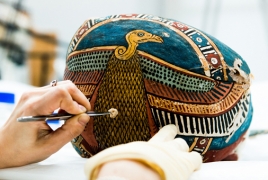
Liverpool’s World Museum opened the doors of its new Ancient Egypt: A journey through time gallery, revealing one of the UK’s most significant collections of ancient Egyptian and Nubian antiquities, Art Daily reports.
The gallery has trebled in size to create the biggest ever display area for its ancient Egypt collection. At 1,000 square metres, it is the UK’s largest ancient Egypt gallery outside of the British Museum.
The new, enhanced gallery sees around 1,000 key objects displayed including many items that have never been on public display before such as a recently identified statue part of Nefertiti and two mummy masks, including one with a magnificent representation of the vulture goddess Nekhbet, her wings outstretched and patterned. Also new on display are Djed-hor’s Book of the Dead and a brightly painted coffin belonging to a man named Haty from 8th century BC Thebes. The coffin comes from the collection of Sir Robert Mond of Wigan, an industrial chemist whose chief hobby was Egyptian archaeology.
Also new on display, and displayed for the first time, is a reassembled Predynastic burial (3200 BC), discovered in the desert sand in 1906 by John Garstang of the University of Liverpool. This better reflects how approximately 90% of people relied on sand to bring decomposition to a halt, as mummification was a skilled and time-consuming process which most could not afford.
The larger gallery also gives space to redisplay objects that were damaged in 1941 when World Museum was bombed in the Blitz. A number of objects are on display for the first time in 76 years, after the Second World War, including several mummies and artefacts from the royal city of Meroe in northern Sudan, borrowed by the Louvre Museum in 2010 for an exhibition about ancient Egypt’s southern neighbours, the Kushites.
The extended gallery also sees the reopening of World Museum’s Mummy Room for the first time in 150 years. With a total of ten mummies on display, this is the UK’s largest display of mummies outside of the British Museum, and double the number of mummies on display at the Museum previously.
The atmospheric Mummy Room houses nine mummies, four of which are being displayed for the first time after the Museum Blitz of 1941 - a female temple musician called Ankh-es-en-aset; a woman called Ta-enty who was buried in her bedsheets; a teenage woman whose name remains unknown to us, and a priest from Abydos called Hor-wen-nefer.
There is an additional mummy in the main gallery, the mummy of Nesmin, who served as a priest in the temple of the male fertility god Min 2,300 years ago. Recent CT scans revealed Nesmin died from a fall. The mummy and coffins were previously owned by Sir Rider Haggard, author of King Solomon’s Mines.
Steve Judd, Director of World Museum, said: “Our mummy collection is world-renowned and has always proved to be incredibly popular with visitors of all ages.
“Until now, space restrictions have limited us from showing the full scope of our collections. By expanding the gallery, we look forward to wowing visitors with never-before seen objects displayed in new and exciting ways.”
World Museum’s ancient Egypt collection has been amassed over more than 150 years. The gallery takes visitors on a journey spanning 5,000 years of history from the time of the first settlers in the Nile Valley through to the impact of the Roman Empire. The collections are presented in seven themes: 5,000 Years; Collection Highlights; River Nile; People of Egypt; African Kingdoms; Afterlife; and the Mummy Room. Visitors can find out about Liverpool’s long connection to excavations in Egypt and Sudan, and how thousands of artefacts made their way into the Museum.
In Victorian times Liverpool’s Egyptian collection was the largest after the British Museum and was displayed in the main hall of the Museum. In the May Blitz of 1941, more than 3,000 Egyptian objects were destroyed when the Museum was hit by an incendiary bomb. The collection increased in size over the following 40 years, with 10,000 new acquisitions. The dedicated gallery that opened in 1976 was modest, with just two mummies on display, and improvements to the gallery in 2008 allowed a further three mummies to be brought out of storage.

